15 Rendering and Outputting
Lesson overview
In this lesson, you’ll learn how to do the following:
Output movies using the Render Queue.
Create templates for the Render Queue.
Output movies using Adobe Media Encoder.
Select the appropriate compressor for your delivery format.
Use pixel aspect ratio correction.
Produce a test version of a composition.
Create custom encoding presets in Adobe Media Encoder.
Render and output a web version of the final composition.
The total amount of time required to complete this lesson depends in part on the speed of your processor and the amount of RAM available for rendering. The amount of hands-on time required is less than an hour. Download the project files for this lesson, following the instructions in the Getting Started section under “Accessing the lesson files and Web Edition,” if you haven’t already done so. As you work on this lesson, you’ll preserve the start files. If you need to restore the start files, download them from your Account page.
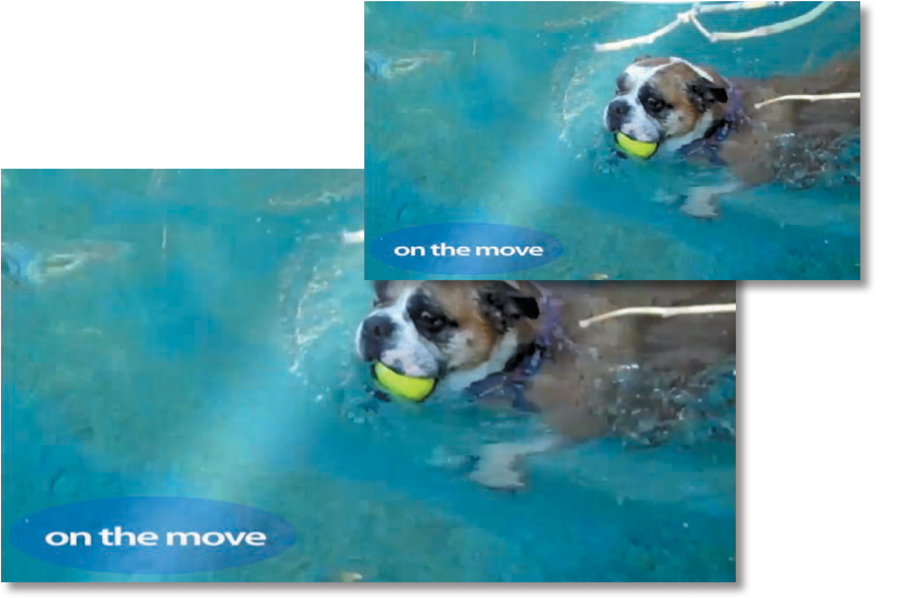
WEB
PROJECT: OUTPUTTING YOUR PROJECT FOR MULTIPLE USES
BROADCAST
The success of any project depends on your ability to deliver it in the format you need, whether it’s for the web or broadcast output. Using Adobe After Effects and Adobe Media Encoder, you can render and export a final composition in a variety of formats and resolutions.
Getting started
This lesson continues from the point at which many of the preceding lessons end: when you’re ready to output the final composition. In order to produce several versions of the animation for this lesson, you’ll explore options available within the Render Queue panel and Adobe Media Encoder. For this lesson, we provide you with a starting project file that is essentially the final composition from Lesson 1 of this book.
Make sure the following files are in the Lessons/Lesson15 folder on your hard disk, or download them from your Account page at www.peachpit.com now:
In the Assets folder: movement.mp3, swimming_dog.mp4, title.psd
In the Start_Project_File folder: Lesson15_Start.aep
In the Sample_Movies folder: Lesson15_Draft_RQ.avi, Lesson15_Draft_RQ.mov, Lesson15_Final_Web.mp4, Lesson15_HD-test_1080p.mp4, Lesson15_Lowres_YouTube.mp4
Open and play the sample movies for Lesson 15, which represent different final versions of the movie—rendered with different quality settings—that you created in Lesson 1. (If you’re using Windows, watch the Lesson15_Draft_RQ.avi movie, and if you’re using macOS, watch the Lesson15_Draft_RQ.mov movie.) When you’re done viewing the sample movies, quit Windows Movies & TV or QuickTime Player. You may delete the sample movies from your hard disk if you have limited storage space.
As always, when you begin the lesson, restore the default application settings for After Effects. See “Restoring default preferences” on page 3.
![]() Note
Note
The Lesson15_HD_test_1080p.mp4 file includes only the first three seconds of the movie.
Start After Effects, and then immediately hold down Ctrl+Alt+Shift (Windows) or Command+Option+Shift (macOS). When prompted, click OK to delete your preferences.
Click Open Project in the Home window.
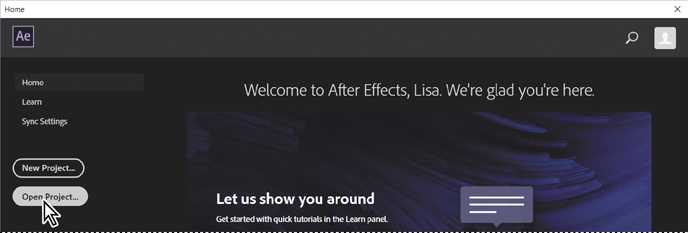
![]() Note
Note
If you receive an error message about missing layer dependencies (Arial Narrow Regular), click OK.
Navigate to the Lessons/Lesson15/Start_Project_File folder, select the Lesson15_Start.aep file, and click Open.
Choose File > Save As > Save As.
In the Save As dialog box, navigate to the Lessons/Lesson15/Finished_Project folder.
Name the project Lesson15_Finished.aep, and then click Save.
About rendering and output
Rendering a composition creates the frames of a movie from all the layers, settings, effects, and other information that makes up the model for that image. After Effects renders content every time it creates a preview, but this lesson focuses on the rendering process that occurs when you’ve completed your composition and are ready to share your movie. You can generate a final movie file using the Render Queue panel in After Effects or Adobe Media Encoder. (The Render Queue uses an embedded version of Adobe Media Encoder to encode most movie formats, but doesn’t include all the features of the separate application.)
When you use the Render Queue to create your final output, there are two steps to the process: After Effects renders the composition and then encodes the rendered frames into output files. In the Render Queue, the first step is governed by the render settings you’ve selected, and the second by the selected output module.
Adobe recommends that you use Adobe Media Encoder to create a high-quality movie file that is compressed for the web, DVD, or Blu-ray disc.
Exporting using the Render Queue
You can export a movie using the Render Queue at any stage in the process—whether you’re creating a sample for a client to review, producing a low-res version to check the timing, or ready to create a final high-resolution movie. The settings you choose for each purpose are different, but the process is the same.
You’ll export a draft version of the On the Move movie using the Render Queue.
![]() Tip
Tip
Alternatively, you can drag the composition from the Project panel onto the Render Queue panel.
Select the Movement composition in the Project panel, and choose Composition > Add To Render Queue.

After Effects opens the Render Queue panel. The Movement composition is in the queue. Note the default settings in the Render Settings and Output Module pop-up menus; by default, After Effects produces a full-size high-quality movie. You’ll change the settings to create a low-resolution test file that will render quickly.
Click the arrow to the right of Render Settings, and choose Draft Settings. Then, click the blue words “Draft Settings.”

After Effects opens the Render Settings dialog box. You’ll use most of the settings preselected in the Draft Settings template, but you’ll reduce the resolution and ensure the entire composition is rendered.
In the Render Settings dialog box, choose Third for Resolution.
When you choose Third, After Effects renders one-ninth of the pixels in the composition: one-third of the rows and one-third of the columns.
In the Time Sampling area, choose Length of Comp for Time Span.
Click OK to close the Render Settings dialog box.

Choose Lossless from the Output Module pop-up menu, if it’s not already selected.
You can make changes to the Output Module settings by clicking the blue text next to Output Module. For now, you’ll accept the default settings.
Click the blue words next to Output To.

In the Output Movie To dialog box, locate the Lessons/Lesson15 folder, and create a new folder called Final_Movies:
In Windows, click New Folder, and then type the name for the folder.
In macOS, click the New Folder button, name the folder, and click Create.
Open the Final_Movies folder, if it’s not already open.
Name the file Draft_RQ.avi (Windows) or Draft_RQ.mov (macOS), and then click Save to return to the Render Queue panel.

Click the Render button in the Render Queue panel.

After Effects renders the movie. If there were additional movies—or the same movie with different settings—in the queue, After Effects would render those, too.
![]() Note
Note
You do not need to render a movie multiple times to export it to multiple formats with the same render settings. You can export multiple versions of the same rendered movie by adding output modules to a render item in the Render Queue panel.
Navigate to the Lessons/Lesson15/Final_Movies folder, and then double-click your movie to preview it.
If you need to make any final changes to the movie, reopen the composition and make those adjustments now. Remember to save your work when you finish, and then output the test movie again using the appropriate settings. After examining the test movie and making any necessary changes, you’ll proceed with outputting the movie for full-resolution broadcast.
![]() Tip
Tip
It’s easy to create an animated GIF from just about any short movie. Just add the composition to the Adobe Media Encoder queue, and choose Animated GIF for the format.
Creating templates for the Render Queue
When you output a composition, you can select individual render and output-module settings. However, you can also use templates to apply settings quickly. Templates are presets that streamline the setup process when you render items for the same type of delivery format. After you define templates, they appear in the Render Queue panel on the appropriate pop-up menu (Render Settings or Output Module). Then, when you’re ready to render a composition, you can simply select the appropriate template for the delivery format that your job requires, and the template applies all the settings.
Creating a render-settings template
You can create render-settings templates for different circumstances. For example, you could create templates for rendering draft copies for review, high-res versions, or different frame rates.
To create a render-settings template, choose Edit > Templates > Render Settings. In the Settings area of the Render Settings Template dialog box, click New to create a new template. Then select the appropriate settings for the template. For Settings Name, type a name that describes the template’s purpose or use (for example, Test_lowres). Click OK when you’ve made the changes.
Render-settings templates you’ve saved are available on the Render Settings pop-up menu in the Render Queue panel.
Creating templates for output modules
You can use a similar process to create a template for output-module settings. Each output-module template includes unique combinations of settings appropriate for a specific type of output.
To create a template, choose Edit > Templates > Output Module to open the Output Module Templates dialog box. In the Settings area, click New to create a new template. Then select the appropriate settings for the template. Name the template to indicate the output it will generate, and click OK to close the dialog box.
Output-module templates you’ve saved are available on the Output Module pop-up menu in the Render Queue panel.
Rendering movies with Adobe Media Encoder
Your movie is ready for final output. Adobe Media Encoder, which is installed when you install After Effects, has the widest selection of codecs available for different delivery formats, including popular video services such as YouTube.
![]() Note
Note
If Adobe Media Encoder is not currently installed on your system, install it from Creative Cloud.
Rendering a broadcast-quality movie
First, you’ll select settings to render your movie in a quality suitable for broadcast.
![]() Tip
Tip
You can also drag a composition into the Render Queue panel, and click Queue in AME to add it to the Adobe Media Encoder queue.
In the Project panel, select the Movement composition, and choose Composition > Add To Adobe Media Encoder Queue.
After Effects opens Adobe Media Encoder and adds your composition with default render settings. Your default settings may vary from ours.
Click the blue link in the Preset column.

Adobe Media Encoder connects to the Dynamic Link server, which may take a few moments.
![]() Tip
Tip
If you don’t need to change anything else in the Export Settings dialog box, you can change the preset using the Preset pop-up menu in the Queue panel.
When the Export Settings dialog box appears, choose H.264 from the Format menu, and then choose High Quality 1080p HD from the Preset menu.

Rendering the full movie with the High Quality 1080p HD preset may take several minutes. You’ll change the settings to render only the first three seconds of the movie so that you can preview the quality. You can change the range rendered using the time ruler at the bottom of the Export Settings dialog box.
Move the current-time indicator to 3:00, and then click the Set Out Point button (
 ) to the left of the Select Zoom Level pop-up menu.
) to the left of the Select Zoom Level pop-up menu.

Click OK to close the Export Settings dialog box.
Click the blue link in the Output File column. Name the movie HD-test_1080p.mp4, and specify the Lessons/Lesson15/Final_Movies folder. Then click Save or OK.

You’re ready to output this movie, but you’ll set up a few additional movie options in the queue before you render it.
Adding another encoding preset to the queue
Adobe Media Encoder comes with dozens of built-in presets suitable for output for traditional broadcast, mobile devices, and the web. You’ll output a version of your composition ready for posting to YouTube.
![]() Tip
Tip
If you render files frequently, consider setting up a “watch folder.” When you place a file in the watch folder, Adobe Media Encoder automatically encodes it using the settings you’ve specified in the Watch Folders panel.
In the Preset Browser panel, navigate to Web Video > Social Media > YouTube 480p SD Wide.

Drag the YouTube 480p SD Wide preset onto the Movement composition in the Queue panel.
Adobe Media Encoder adds another output item to the queue.

Click the blue link in the Output File column for the item you just added. Then name the file Final_Web.mp4, specify the Lessons/Lesson15/Final_Movies folder, and click Save or OK.
Rendering movies
You’ve set up two versions of your movie in the queue. Now you’ll render and view them. Rendering is resource-intensive, and it can take a while, depending on your system, the complexity and length of the composition, and the settings you use.
Click the green Start Queue button (
 ) in the upper right corner of the Queue panel.
) in the upper right corner of the Queue panel.

![]() Depending on your system, this may take a while.
Depending on your system, this may take a while.
Adobe Media Encoder encodes the movies in the queue simultaneously, displaying a status bar and reporting the estimated time remaining.
When Adobe Media Encoder has finished, navigate to the Final_Movies folder in the Finder or Explorer, and double-click your files to play them.
![]() Tip
Tip
If you forget where you saved your encoded movies, click the blue link in the Output File column next to the finished movie. Adobe Media Encoder opens a window to show you where your files were saved.
Creating custom presets for Adobe Media Encoder
In most cases, one of the default Adobe Media Encoder presets will be appropriate for your project. However, you can create your own encoding presets if you have specialized needs. In this case, you’ll create a preset that renders a lower-resolution file for YouTube more quickly than the one you just encoded.
Click the Create New Preset Group button (
 ) at the top of the Preset Browser panel, and give the group a unique name, such as your name.
) at the top of the Preset Browser panel, and give the group a unique name, such as your name.Click the Create New Preset button (
 ), and choose Create Encoding Preset.
), and choose Create Encoding Preset.
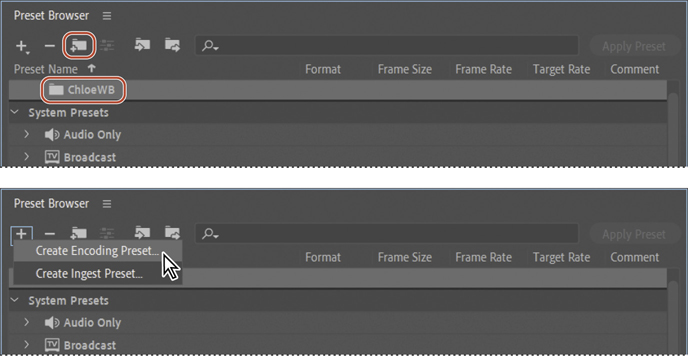
Do the following in the Preset Settings dialog box:
Name the preset Low-res_YouTube.
Make sure H.264 is chosen from the Format menu.
Choose YouTube 480p SD Wide from the Based On Preset menu.

Select the Video tab, if it’s not already selected.
For Frame Rate, deselect Based On Source.
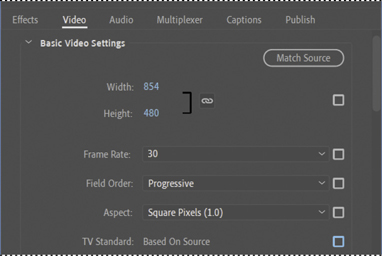
Choose Baseline from the Profile menu. (You may need to scroll down to see it and the following options.)
Choose 3.0 from the Level menu.
Make sure VBR, 1 Pass is chosen from the Bitrate Encoding menu.
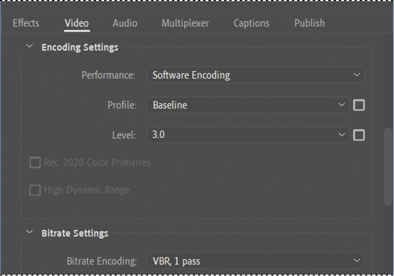
Click the Audio tab, and choose 44100 Hz from the Sample Rate menu and Medium from the Audio Quality menu.
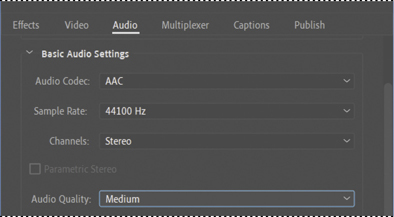
Click OK to close the Preset Settings dialog box.
Drag the Low-res_YouTube preset onto the Movement composition in the Queue panel.
Click the blue link in the Output File column. Then name the file Lowres_YouTube, specify the Lessons/Lesson15/Final_Movies folder, and click Save or OK.
Click the Start Queue button (
 ).
).
With the settings in your new preset, the movie encodes more quickly. However, the quality isn’t as high.
When Adobe Media Encoder has finished, navigate to the Final_Movies folder in Explorer or the Finder, and double-click the Lowres_YouTube movie to view it.
You have created both a web version and a broadcast version of the final composition.
Congratulations! You have completed all the lessons in Adobe After Effects CC Classroom in a Book (2019 Release).
While this book is intended to give you a good foundation for working with After Effects, it can’t cover everything. To continue learning about After Effects, check out the resources described in the Getting Started section at the beginning of the book.
Review questions
1 What is compression, and what are some things you should consider when compressing files?
2 How can you output a movie using Adobe Media Encoder?
3 Name two types of templates you can create for use in the Render Queue panel, and explain when and why to use them.
Review answers
1 Compression is essential to reduce the size of movies so that they can be stored, transmitted, and played back effectively. When exporting or rendering a movie file for playback on a specific type of device at a certain bandwidth, you choose a compressor/decompressor, or codec, to compress the information and generate a file readable by that type of device at that bandwidth. A wide range of codecs is available; no single codec is the best for all situations. For example, the best codec for compressing cartoon animation is generally not efficient for compressing live-action video. When compressing a movie file, you can fine-tune it for the best quality playback on a computer, a video playback device, the web, or from a DVD player. Depending on which encoder you use, you may be able to reduce the size of compressed files by removing artifacts that interfere with compression, such as random camera motion and excessive film grain.
2 To output a movie using Adobe Media Encoder, select the composition in the Project panel in After Effects, and then choose Composition > Add To Adobe Media Encoder Queue. In Adobe Media Encoder, select an encoding preset and any other settings, name the output file, and click the Start Queue button.
3 In After Effects, you can create templates for both render settings and output-module settings. These templates are presets that you can use to streamline the setup process when you render items for the same type of delivery format. After you define these templates, they appear in the Render Queue panel on the appropriate pop-up menu (Render Settings or Output Module). Then, when you’re ready to render a job, you can simply select the template that is appropriate for the delivery format that your job requires, and the template applies all the settings.
